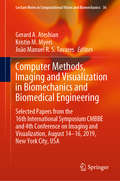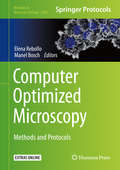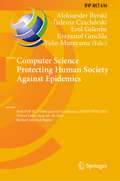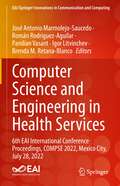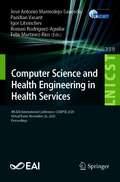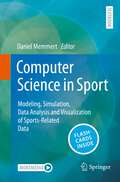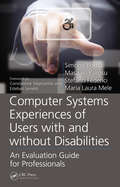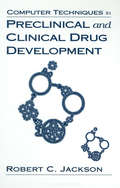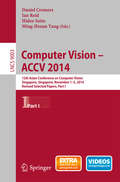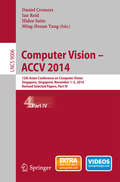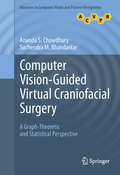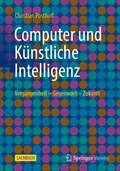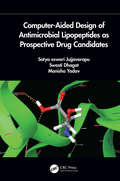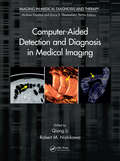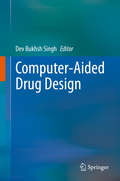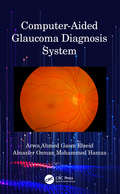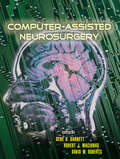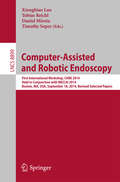- Table View
- List View
Computer Methods, Imaging and Visualization in Biomechanics and Biomedical Engineering: Selected Papers from the 16th International Symposium CMBBE and 4th Conference on Imaging and Visualization, August 14-16, 2019, New York City, USA (Lecture Notes in Computational Vision and Biomechanics #36)
by João Manuel R. S. Tavares Gerard A. Ateshian Kristin M. MyersThis book gathers selected, extended and revised contributions to the 16th International Symposium on Computer Methods in Biomechanics and Biomedical Engineering, and the 4th Conference on Imaging and Visualization (CMBBE 2019), held on August 14-16, 2019, in New York City, USA. It reports on cutting-edge models and algorithms for studying various tissues and organs in normal and pathological conditions; innovative imaging and visualization techniques; and the latest diagnostic tools. Further topics addressed include: numerical methods, machine learning approaches, FEM models, and high-resolution imaging and real-time visualization methods applied for biomedical purposes. Given the scope of its coverage, the book provides graduate students and researchers with a timely and insightful snapshot of the latest research and current challenges in biomedical engineering, computational biomechanics and biological imaging, as well as a source of inspiration for future research and cross-disciplinary collaborations.
Computer Optimized Microscopy: Methods and Protocols (Methods in Molecular Biology #2040)
by Elena Rebollo Manel BoschThis volume explores open-source based image analysis techniques to provide a state-of-the-art collection of workflows covering current bioimage analysis problematics, including colocalization, particle counting, 3D structural analysis, ratio imaging and FRET quantification, particle tracking, high-content screening or machine learning. Written in the highly successful Methods in Molecular Biology series format, chapters include introductions to their respective topics, lists of the necessary materials and scripts, step-by-step, readily reproducible image analysis protocols, and tips on troubleshooting and avoiding known pitfalls.Comprehensive and cutting-edge, Computer Optimized Microscopy: Methods and Protocols is a valuable resource for both novice and experienced researchers who are interested in learning more about this developing field.
Computer Science Protecting Human Society Against Epidemics: First IFIP TC 5 International Conference, ANTICOVID 2021, Virtual Event, June 28–29, 2021, Revised Selected Papers (IFIP Advances in Information and Communication Technology #616)
by Erol Gelenbe Yuko Murayama Tadeusz Czachórski Krzysztof Grochla Aleksander ByrskiThis book constitutes the refereed post-conference proceedings of the First IFIP TC 5 International Conference on Computer Science Protecting Human Society Against Epidemics, ANTICOVID 2021, held virtually in June 2021.The 7 full and 4 short papers presented were carefully reviewed and selected from 20 submissions. The papers are concerned with a very large spectrum of problems, ranging from linguistics for automatic translation of medical terms, to a proposition for a worldwide system of fast reaction to emerging pandemic.
Computer Science and Engineering in Health Services: 5th EAI International Conference, COMPSE 2021, Virtual Event, July 29, 2021, Proceedings (Lecture Notes of the Institute for Computer Sciences, Social Informatics and Telecommunications Engineering #393)
by Pandian Vasant Igor Litvinchev José Antonio Marmolejo-Saucedo Roman Rodríguez-Aguilar Jania Astrid Saucedo-MartínezThis book constitutes the refereed post-conference proceedings of the 5th International Conference on Computer Science and Engineering in Health Services, COMPSE 2021, held in July 2021. Due to COVID-19 pandemic the conference was held virtually. The 17 full papers presented were carefully reviewed and selected from 46 submissions. The papers are grouped on thematic topics: application of tools delivered by the COVID-19 pandemic; health services; computer and data science; and industry 4.0 in logistics and supply chain.
Computer Science and Engineering in Health Services: 6th EAI International Conference Proceedings, COMPSE 2022, Mexico City, July 28, 2022 (EAI/Springer Innovations in Communication and Computing)
by Pandian Vasant Igor Litvinchev José Antonio Marmolejo-Saucedo Román Rodríguez-Aguilar Brenda M. Retana-BlancoThis book constitutes the refereed post-conference proceedings of the 6th EAI International Conference Computer on Science and Engineering in Health Services (COMPSE 2022), which took place in Mexico City and online, June 28th, 2022. The papers are grouped on thematic topics: application of tools delivered by the COVID-19 pandemic; health services; computer and data science; and industry 4.0 in logistics and supply chain. The content is relevant to researchers, academics, students and professionals.
Computer Science and Health Engineering in Health Services: 4th EAI International Conference, COMPSE 2020, Virtual Event, November 26, 2020, Proceedings (Lecture Notes of the Institute for Computer Sciences, Social Informatics and Telecommunications Engineering #359)
by Pandian Vasant Igor Litvinchev José Antonio Marmolejo-Saucedo Roman Rodriguez-Aguilar Felix Martinez-RiosThis book constitutes the refereed post-conference proceedings of the 4th International Conference on Computer Science and Health Engineering in Health Services. Due to COVID-19 pandemic the conference was held virtually. The 16 full papers presented were carefully reviewed and selected from 39 submissions. The papers highlight the latest research innovations and applications of algorithms designed for optimization applications within the fields of science, computer science, engineering, information technology, economics, and health systems.
Computer Science in Sport: Modeling, Simulation, Data Analysis and Visualization of Sports-Related Data
by Daniel MemmertIn recent years, computer science in sport has grown extremely, mainly because more and more new data has become available. Computer science tools in sports, whether used for opponent preparation, competition, or scientific analysis, have become indispensable across various levels of expertise nowadays. A completely new market has emerged through the utilization of these tools in the four major fields of application: clubs and associations, business, science, and the media. This market is progressively gaining importance within university research and educational activities.This textbook aims to live up to the now broad diversity of computer science in sport by having more than 30 authors report from their special field and concisely summarise the latest findings. The book is divided into four main sections: data sets, modelling, simulation and data analysis. In addition to background information on programming languages and visualisation, the textbook is framed by history and an outlook. Students with a connection to sports science are given a comprehensive insight into computer science in sport, supported by a didactically sophisticated concept that makes it easy to convey the learning content. Numerous questions for self-testing underpin the learning effect and ensure optimal exam preparation. For advanced students, the in-depth discussion of time series data mining, artificial neural networks, convolution kernels, transfer learning and random forests offers additional value.
Computer Systems Experiences of Users with and Without Disabilities: An Evaluation Guide for Professionals (Rehabilitation Science in Practice Series)
by Masaaki Kurosu Stefano Federici Simone Borsci Maria Laura MeleThis book provides to manufacturers, designers and evaluation professionals the necessary tools for balancing design and the assessment phases during the product lifecycle. It proposes an integrated model of interaction evaluation for a holistic analysis of the user experience by both discussing in details the interaction testing methods, and promoting the involvement of disabled users in human computer interaction evaluation.
Computer Systems Validation: Quality Assurance, Risk Management, and Regulatory Compliance for Pharmaceutical and Healthcare Companies
by Guy WingateBoth pervasive and ubiquitous, computerized systems are now an integral component of every corporate strategy in pharmaceutical and healthcare companies. However, when technology is combined with high-risk public safety projects or the production and control of life-saving medicines or devices, it is necessary to ensure that it is reliable, quality
Computer Techniques in Preclinical and Clinical Drug Development
by Robert C. JacksonIt is estimated that 80 to 90% of drugs under development never make it to the marketplace due to insufficient clinical activity, unacceptable toxicity, rapid appearance of drug resistance, or other factors that should be, at least partially, predictable from preclinical testing. This new text asks the question, "How can we use computational method
Computer Vision -- ACCV 2014: 12th Asian Conference on Computer Vision, Singapore, Singapore, November 1-5, 2014, Revised Selected Papers, Part I (Lecture Notes in Computer Science #9003)
by Daniel Cremers Ian Reid Hideo Saito Ming-Hsuan YangThe five-volume set LNCS 9003--9007 constitutes the thoroughly refereed post-conference proceedings of the 12th Asian Conference on Computer Vision, ACCV 2014, held in Singapore, Singapore, in November 2014. The total of 227 contributions presented in these volumes was carefully reviewed and selected from 814 submissions. The papers are organized in topical sections on recognition; 3D vision; low-level vision and features; segmentation; face and gesture, tracking; stereo, physics, video and events; and poster sessions 1-3.
Computer Vision -- ACCV 2014: 12th Asian Conference on Computer Vision, Singapore, Singapore, November 1-5, 2014, Revised Selected Papers, Part IV (Lecture Notes in Computer Science #9006)
by Daniel Cremers Ian Reid Hideo Saito Ming-Hsuan YangThe five-volume set LNCS 9003--9007 constitutes the thoroughly refereed post-conference proceedings of the 12th Asian Conference on Computer Vision, ACCV 2014, held in Singapore, Singapore, in November 2014. The total of 227 contributions presented in these volumes was carefully reviewed and selected from 814 submissions. The papers are organized in topical sections on recognition; 3D vision; low-level vision and features; segmentation; face and gesture, tracking; stereo, physics, video and events; and poster sessions 1-3.
Computer Vision-Guided Virtual Craniofacial Surgery: A Graph-Theoretic and Statistical Perspective (Advances in Computer Vision and Pattern Recognition)
by Ananda S. Chowdhury Suchendra M. BhandarkarThis unique text/reference discusses in depth the two integral components of reconstructive surgery; fracture detection, and reconstruction from broken bone fragments. In addition to supporting its application-oriented viewpoint with detailed coverage of theoretical issues, the work incorporates useful algorithms and relevant concepts from both graph theory and statistics. Topics and features: presents practical solutions for virtual craniofacial reconstruction and computer-aided fracture detection; discusses issues of image registration, object reconstruction, combinatorial pattern matching, and detection of salient points and regions in an image; investigates the concepts of maximum-weight graph matching, maximum-cardinality minimum-weight matching for a bipartite graph, determination of minimum cut in a flow network, and construction of automorphs of a cycle graph; examines the techniques of Markov random fields, hierarchical Bayesian restoration, Gibbs sampling, and Bayesian inference.
Computer und Künstliche Intelligenz: Vergangenheit - Gegenwart - Zukunft
by Christian PosthoffDas Buch beginnt mit einer Erklärung der menschlichen Intelligenz und der Beschreibung von Intelligenztests. Die Künstliche Intelligenz, die auf Computerprogrammen beruht, beginnt mit der Dartmouth – Konferenz 1956, an der sich berühmte Informatiker dieser Zeit beteiligten. Diese damit eingeleitete Entwicklung wurde von großen Fortschritten der Kybernetik und der Spieltheorie begleitet.Es folgen Beschreibungen wichtiger Methoden und Anwendungen:Maschinelles Lernen und Neuronale Netze Sehr publikumswirksam waren die Entwicklungen von Programmen für strategische Spiele, die nach einem kurzen Training die jeweiligen Weltmeister besiegen konnten. Die Sprachübersetzer von Google und DeepL sind mittlerweile vielen bekannt. Es wird erklärt, wie intelligente Systeme mit Datenbanken zusammenarbeiten, wie beliebige Daten digitalisiert werden können. Große Mengen an Daten werden unter dem Stichwort „Big Data“ behandelt. Ausführlich beschrieben werden die Bildverarbeitung, die Erkennung von Tumoren und Viren. Robotik ist ein weiterer Punkt, der ausführlich dargestellt wird. Roboter in der Chirurgie und in der Pflege sind ebenfalls sehr bedeutsam. „Exotische Ausreißer“ sind die Anwendungen in der Kunst. Sehr bedeutsam für die zukünftige Entwicklung sind Anwendungen in der Rechtssprechung.
Computer-Aided Analysis of Gastrointestinal Videos
by Jorge Bernal Aymeric HistaceThis book opens with an introduction to the main purpose and tasks of the GIANA challenge, as well as a summary and an analysis of the results and performance obtained by the 20 participating teams. The early and accurate diagnosis of gastrointestinal diseases is critical for increasing the chances of patient survival, and efficient screening is vital for locating precursor lesions. Video colonoscopy and wireless capsule endoscopy (WCE) are the gold-standard tools for colon and intestinal tract screening, respectively. Yet these tools still present some drawbacks, such as lesion miss rate, lack of in vivo diagnosis capabilities, and perforation risk. To mitigate these, computer-aided detection/diagnosis systems can play a key role in assisting clinicians in the different stages of the exploration.This book presents the latest, state-of-the-art approaches in this field, and also tackles the clinical considerations required to efficiently deploy these systems in the exploration room. The coverage draws upon results from the Gastrointestinal Image Analysis (GIANA) Challenge, part of the EndoVis satellite events of the conferences MICCAI 2017 and 2018. Each method proposed to address the different subtasks of the challenges is detailed in a separate chapter, offering a deep insight into this topic of interest for public health.This book appeals to researchers, practitioners, and lecturers spanning both the computer vision and gastroenterology communities.
Computer-Aided Antibody Design (Methods in Molecular Biology #2552)
by Kouhei Tsumoto Daisuke KurodaThis volume details state-of-the- art methods on computer-aided antibody design. Chapters guide readers through information on antibody sequences and structures, modeling antibody structures and dynamics, prediction and optimization of biological and biophysical properties of antibodies, prediction of antibody-antigen interactions, and computer-aided antibody affinity maturation and beyond. Written in the format of the highly successful Methods in Molecular Biology series, each chapter includes an introduction to the topic, lists necessary materials and reagents, includes tips on troubleshooting and known pitfalls, and step-by-step, readily reproducible protocols. Authoritative and cutting-edge, Computer-Aided Antibody Design aims to be a useful and practical guide to new researchers and experts looking to expand their knowledge. Chapter 2 is available open access under a Creative Commons Attribution 4.0 International License via link.springer.com.
Computer-Aided Design of Antimicrobial Lipopeptides as Prospective Drug Candidates
by Manisha Yadav Jujjvarapu Satya Eswari Swasti DhagatIncrease in antibiotic resistance has forced researchers to develop new drugs against microorganisms. Lipopeptides are produced as secondary metabolites by some microorganisms. Computer-aided Design of Antimicrobial Lipopeptides as Prospective Drug Candidates provides the identification of novel ligands for different antimicrobial lipopeptides. Along with identification, it also provides some of the in silico drug design processes, namely homology modelling, molecular docking, QSAR studies, drug ADMET studies and pharmacophore studies to check the ligand-lipopeptide interaction. Some lipopeptides have shown anti-cancerous properties too, and this book discusses the required templates to design new drugs using computational techniques. Key Features: Focuses on the use lipopeptides as new antimicrobial compounds Presents the basics of in silico modelling for design and development of new drug molecules, and is therefore of interest to beginners in the field Provides a step-by-step process for identification of drug molecules and testing its efficacy in silico Couples with courses on patents and intellectual property rights
Computer-Aided Detection and Diagnosis in Medical Imaging (Imaging in Medical Diagnosis and Therapy)
by Qiang Li Robert M. NishikawaImprove the Accurate Detection and Diagnosis of Cancer and Other DiseasesDespite the expansion of the CAD field in recent decades, there is currently no single book dedicated to the development and use of CAD systems. Filling this need, Computer-Aided Detection and Diagnosis in Medical Imaging covers the major technical advances and methodologies s
Computer-Aided Drug Design
by Dev Bukhsh SinghThis book provides up-to-date information on bioinformatics tools for the discovery and development of new drug molecules. It discusses a range of computational applications, including three-dimensional modeling of protein structures, protein-ligand docking, and molecular dynamics simulation of protein-ligand complexes for identifying desirable drug candidates. It also explores computational approaches for identifying potential drug targets and for pharmacophore modeling. Moreover, it presents structure- and ligand-based drug design tools to optimize known drugs and guide the design of new molecules. The book also describes methods for identifying small-molecule binding pockets in proteins, and summarizes the databases used to explore the essential properties of drugs, drug-like small molecules and their targets. In addition, the book highlights various tools to predict the absorption, distribution, metabolism, excretion (ADME) and toxicity (T) of potential drug candidates. Lastly, it reviews in silico tools that can facilitate vaccine design and discusses their limitations.
Computer-Aided Drug Discovery (Methods in Pharmacology and Toxicology)
by Wei ZhangThis detailed volume examines computer-aided drug discovery(CADD), a crucial component of modern drug discovery programs that is widelyutilized to identity and optimize bioactive compounds for the development ofnew drugs. With a focus on the methods that are commonly used in the earlystage of drug discovery, chapters explore computer simulation, structureprediction, conformational sampling, binding site mapping, docking and scoring,in silico screening, and fragment-based drug design. In addition to the state-of-the-arttheoretical concept, this book also includes step-by-step, readily reproduciblecomputational protocols as well as examples of various CADD strategies. The limitations and potential pitfalls ofdifferent computational methods are discussed by experts, and tips and advicefor their applications are suggested. Practical and thorough, Computer-AidedDrug Discovery serves as an ideal addition to the Methods in Pharmacology and Toxicology series, guiding researcherstoward their lab's goals with this exciting and versatile technology.
Computer-Aided Glaucoma Diagnosis System
by Arwa Ahmed Gasm Elseid Alnazier Osman Mohammed HamzaGlaucoma is the second leading cause of blindness globally. Early detection and treatment can prevent its progression to avoid total blindness. This book discusses and reviews current approaches for detection and examines new approaches for diagnosing glaucoma using CAD system. Computer-Aided Glaucoma Diagnosis System, Chapter 1 provides a brief introduction of the disease and current methodology used to diagnose it today. Chapter 2 presents a review of the medical background of the disease, followed by a theoretical and mathematical background used in fundus image processing. Chapter 3 is a literature review about segmentation and feature extraction. Chapter 4 describes the formulation of the proposed methodology. In Chapter 5, the results of optic disc and optic cup segmentation algorithm are presented, the feature extraction and selection method, experimental results and performance evaluations of the classifier are given. Chapter 6 presents the conclusions and discussion of the future potential for the diagnostic system. This book is intended for biomedical engineers, computer science students, ophthalmologists and radiologists looking to develop a reliable automated computer-aided diagnosis system (CAD) for detecting glaucoma and improve diagnosis of the disease. Key Features Discusses a reliable automated computer-aided diagnosis system (CAD) for detecting glaucoma and presents an algorithm that detects optic disc and optic cup Assists ophthalmologists and researchers to test a new diagnostic method that reduces the effort and time of the doctors and cost to the patients Discusses techniques to reduce human error and minimize the miss detection rate and facilitate early diagnosis and treatment Presents algorithms to detect cup and disc color, shape features and RNFL texture features Dr. Arwa Ahmed Gasm Elseid is an assistant professor, Department of Biomedical Engineering, Sudan University of Science and Technology, Khartoum, Sudan. Dr. Alnazier Osman Mohammed Hamza is professor of Medical Imaging, College of Engineering, Sudan University of Sciences and Technology, Khartoum, Sudan.
Computer-Aided Intelligent Diagnosis of Skin Melanoma
by Shuli Guo Lina Han Xiaowei SongThis book is intended primarily for researchers, engineers, and graduate students in the fields of medicine management and software engineering in the field of dermatology. Aiming at the problems of color deviation, structured noise interference, and uneven distribution of feature points in the identification of melanoma, this book researches four aspects of dermoscopic image such as color correction, hair removal, image registration and classification recognition. Some creative methods are presented as follows, 1 Dermoscopic image color correction, 2 Dermoscopic image hair removal, 3 Dermoscopic image registration. In writing style, a combination of diagrams, tables, formula and text is used in order that the book can be understood easily and raise the readers&’ interest, and in content, theoretical analysis and medical application are combined to describe the advanced technologies in every chapter.
Computer-Assisted Musculoskeletal Surgery: Thinking and Executing in 3D
by Lucas E. Ritacco Federico E. Milano Edmund ChaoComputer-Assisted Surgery (CAS) is a new tool for performing complex procedures in a predictable and safe way. This book is designed to serve as a comprehensive review of Computer-Assisted Surgery, covering the current status of both research and applications. CAS includes Virtual Preoperative Planning (VPP) and Intraoperative Virtual Navigation (IVN), which are a set of technologies used to measure oncological margins in 3-Dimensions (3D), to locate small intraosseous tumors and apply controlled resections preserving anatomical structures. During VPP, patient acquired multimodal images are processed and an interactive virtual scenario is created. This can then be used as a platform to measure oncological distances and preplan osteotomies in safe areas. IVN is a procedure which allows the execution of the VPP with a mean error of less than 3mm. For the student, medical doctors, research and development scientists or new researchers, the protocols are central to the performance of Computer-Assisted technologies.
Computer-Assisted Neurosurgery
by Gene H. Barnett David W. Roberts Robert J. MaciunasRichly illustrated to showcase the best practices, surgical methods, and procedures for difficult situations in neurosurgery, this reference demonstrates strategies to manage brain metastases, intracranial gliomas and meningiomas, pituitary region tumors, and intracranial vascular malformations; spinal operations; and surgeries of the skull base wi
Computer-Assisted and Robotic Endoscopy: First International Workshop, CARE 2014, Held in Conjunction with MICCAI 2014, Boston, MA, USA, September 18, 2014. Revised Selected Papers (Lecture Notes in Computer Science #8899)
by Xiongbiao Luo Tobias Reichl Daniel Mirota Timothy SoperThis book constitutes the refereed proceedings of the First International Workshop on Computer Assisted and Robotic Endoscopy, CARE 2014, held in conjunction with MICCAI 2014, in Boston, MA, USA, in September 2014. The 12 papers presented focus on recent technical advances associated with computer vision; graphics; robotics and medical imaging; external tracking systems; medical device control systems; information processing techniques; endoscopy; planning and simulation.
